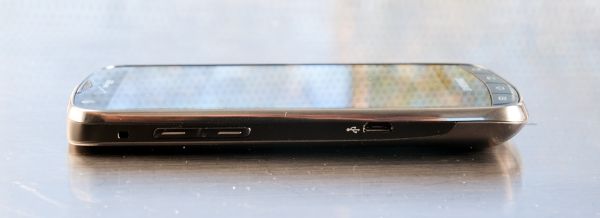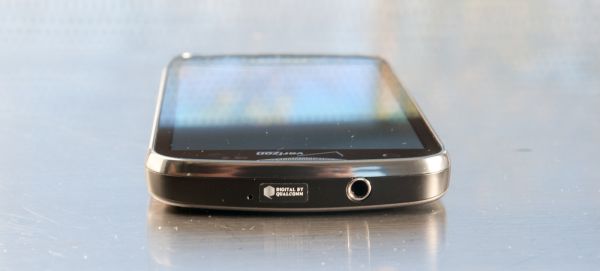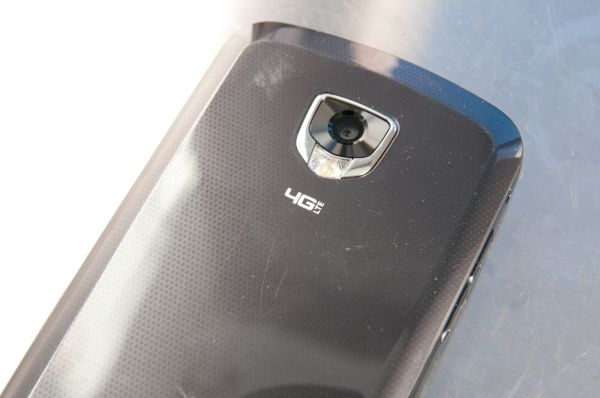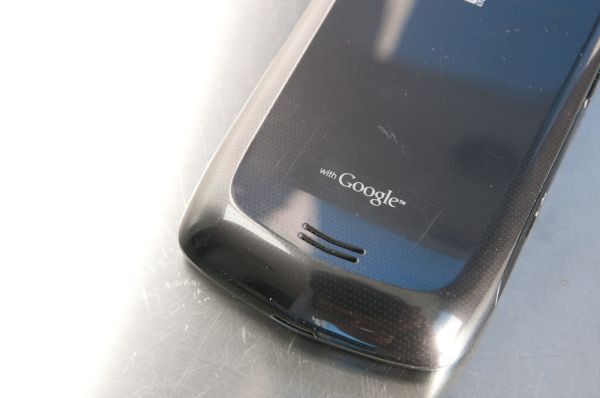Samsung Droid Charge Review - Droid Goes LTE
by Brian Klug on June 22, 2011 7:47 AM EST- Posted in
- Smartphones
- Samsung
- LTE
- 4G
- Droid Charge
- Mobile
The left side of the Charge is home to the microUSB port and volume buttons, which are adorned with a small chrome ridge. The volume buttons on the Charge are precise and clicky, no complaints there. Having the USB port located here remains something of a point of contention for many people, though I’m starting to warm up to it.
The right side packs the Charge’s HDMI port which is underneath an attached plastic cover. Get a thumb inside there and the cover pries off and swivels around exposing the HDMI type-D port. Just north of that is the power button, which like the volume buttons is the right balance between clicky and resistive enough to not lend itself to errant presses, and is easily locatable thanks to its raised shape. I’m impressed with all the buttons on the Charge - a small thing that definitely makes a difference for actual in-hand impressions in the long run.
Up at the very top of the Charge is an offset headphone jack, microphone for noise cancellation in calls, and a "Digital by Qualcomm" sticker. As we'll discuss later however, there's no Qualcomm parts inside, but if you license CDMA2000 you still need this sticker on the handset.
Where the Charge falls apart in the physical department is the back cover. This is something we’ve harped endlessly on about with the Galaxy S series, with the Fascinate, with the Nexus S, and in essentially the entire new Samsung Android lineup other than the Charge, it’s fixed. On the Galaxy S 2, the back is now textured instead of one featureless slick plastic face like it is with the original Galaxy S and now the Charge.
As a result, the Charge picks up scratches on the back disappointingly quickly, just like its predecessors. The plastic that Samsung used for this generation seems especially prone to picking up what are called “sleeks” - fine scratches that are only visible from light incident at an angle.
It’s just frustrating because otherwise the Charge has an excellently balanced in-hand feel thanks to its ergonomic lip on the back, and overall impressive build construction. Though the entire exterior of the Charge is plastic, the internal frame is metal, and that rigidity certainly shows through.
| Physical Comparison | ||||||
| Apple iPhone 4 | HTC Thunderbolt | LG Revolution | Samsung Droid Charge | |||
| Height | 115.2 mm (4.5") | 122 mm (4.8") | 129.8 mm (5.11") | 129.9 mm (5.11") | ||
| Width | 58.6 mm (2.31") | 67 mm (2.63") | 66.9 mm (2.63") | 67.5 mm (2.65") | ||
| Depth | 9.3 mm ( 0.37") | 13.2 mm (0.52") | 13.6 mm (0.54") | 11.90-14.96 mm (0.47"-0.59") | ||
| Weight | 137 g (4.8 oz) | 183.3 g (6.46 oz) | 172 g (6.08 oz) | 143 g (5.04 oz) | ||
| CPU | Apple A4 @ ~800MHz | 1 GHz MSM8655 45nm Snapdragon | 1 GHz MSM8655 45nm Snapdragon | 1 GHz Hummingbird S5PC110 | ||
| GPU | PowerVR SGX 535 | Adreno 205 | Adreno 205 | PowerVR SGX 540 | ||
| RAM | 512MB LPDDR1 (?) | 768 MB LPDDR2 | 512 MB LPDDR2 | 512 MB LPDDR2 | ||
| NAND | 16GB or 32GB integrated | 4 GB NAND with 32 GB microSD Class 4 preinstalled | 4GB NAND with 16 GB microSD preinstalled | 2 GB NAND + 32 GB microSD preinstalled | ||
| Camera | 5MP with LED Flash + Front Facing Camera | 8 MP with autofocus and dual LED flash, 720p30 video recording, 1.3 MP front facing | 5 MP with AF and LED flash, 720P video capture, 1.3 MP front facing | 8 MP with AF and LED flash, 720p30 video capture, 1.3 MP front facing | ||
| Screen | 3.5" 640 x 960 LED backlit LCD | 4.3” 800 x 480 LCD-TFT | 4.3" 800 x 480 LCD-TFT | 4.3" 800 x 480 SAMOLED+ | ||
| Battery | Integrated 5.254Whr | Removable 5.18 Whr | Removable 5.6 Whr | Removable 5.92 Whr | ||
Probably the most poignant comparison for the Charge however isn’t Galaxy S, it’s the HTC Thunderbolt and LG Revolution. Compared to the Thunderbolt, the Charge is a fair amount taller - nearly 8 mm in fact. However, the Charge is 1.3mm thinner and around 30 grams lighter. The LG Revolution has roughly the same outline as the Charge and is 0.4 mm thicker than the Thunderbolt. Thickness and overall mass are prime considerations for smartphone shoppers, and I think in this category the Charge’s thinner overall profile makes it more attractive than the other phones purely from a physical perspective.
Update: My thickness numbers in the table for the Charge were previously incorrect, and have been corrected now. Thanks everyone.















61 Comments
View All Comments
crydee - Wednesday, June 22, 2011 - link
Samsung never updates.. I still have the Galaxy first Android on AT&T and still no working GPS.sprockkets - Wednesday, June 22, 2011 - link
I saw the picture and thought this was a review of the new iphone! Oh my! Now I can see why apple is so angry!GFY JOBS!
spctm - Wednesday, June 22, 2011 - link
Not sure why it is so but I am running Cyanogenmod 7.1 nightly on a nexus one and I get these scores.SunSpider: 3354.2
BrowserMark: 54697
Linpack: 36.7 (Free Version)
Sunspider and Browsermark are way faster on cm-7.1, which is quite surprising as it is running Android 2.3.4 base. But Linpack is more along the lines with what Brian got. Not sure if the free version's ad streaming would have some impact on floating point operations of Linpack.
Just thought I would post this observations and see if others have similar results.
silverblue - Wednesday, June 22, 2011 - link
Looks to be a good phone, though I wonder if it'll be better than the Charge.Omid.M - Wednesday, June 22, 2011 - link
"I have an odd Sensation that the next one will be exciting..."Hah!
Can't wait for the Galaxy S 2 review. Hope it lives up to AT expectations.
@moids
name99 - Wednesday, June 22, 2011 - link
"My only complaint is that every once in a while, the LTE data session sometimes stalls briefly – sometimes for a a few seconds, other times for a few minutes. When that happens, you’ll see the uplink green arrow blink, but no orange downlink arrow. Rebooting the device fixes things.
"
Jesus Christ.
THIS is precisely why Apple has nothing to fear, as long as competitor vendors ship crap like this --- and reviewer web sites are so blinded by Apple hatred that they give them a pass. I mean, WTF --- a phone that you, randomly and frequently, have to reboot, and the reviewer thinks this is just par for the course?
This is 2011, not 1982. Forcing a reboot to fix random problems should be a strange and unusual situation, not a daily occurrence!
ThomasA - Wednesday, June 22, 2011 - link
Long time VZW customer, since GTE. This may change. The future should be interesting with the '4G' push, and now, the 'new' Verizon tiered data plans looming. Having a '4G' device will require either a big wallet or detailed restraint.I suggest using a cheap flip-phone for chit-chat and another device on hotspots (laptop, netbook, iPod touch) for web needs. Unless you enjoy transfusing the telecoms.
sitharien - Wednesday, June 22, 2011 - link
You are both correct, I was way mistaken. I look forward to Anand's review. I am holding off on any upgrade of my EVO 4G until I get a better picture of the Android battery landscape.BGK - Wednesday, June 22, 2011 - link
So what's the verdict on Charge vs Thunderbolt. If battery life is about the same, that leaves the screen as the Charge's major advantage.Also, do you think some of discrepancies in battery life in the reviews had to do with the reviews of the thunderbolt being done on older versions that may have been less efficient?
tdenton1138 - Thursday, June 23, 2011 - link
Visit XDA or Android Central forums. You can read up about both phone for people who use them every day... I love my Charge (every phone does seem to have its quirks) and don't imagine I'll bother upgrading for quite some time. Great screen, no lag (voodoo lagfix is needed here - why does Samsung use RFS filesystem when EXT4 is so much better?), acceptable battery, hackable. Until someone can demonstrate a real need for dual+ core on a phone (now tablets perhaps...?), I'm happily sitting out of the upgrade race for a while.